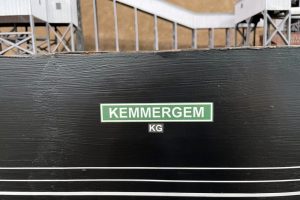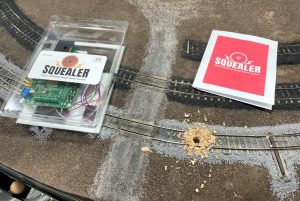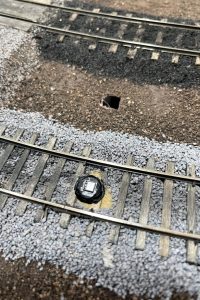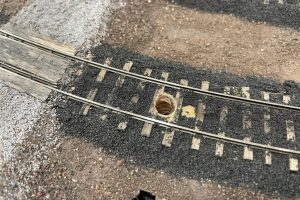
In my last post, I mentioned that we were unable to run all the trains in our ops session. Well enter Dave O. to the rescue! Dave is a great modeler and friend from nearly 2 decades ago when he used to live in Colorado. Dave was out here for a couple days, so he stopped by for some catching up and running of trains. Dave got to run the second half of the St Charles Switcher working Kemmergem and the Gin Creek Branch and pick up the slack from the last crew ;-). This was also an historic moment for the layout as I finally received the two Iowa Scaled Engineering “Proto Throttles” I’ve been waiting on for several weeks. These things, while not cheap, are awesome!
The Proto Throttle is laid out like an older diesel locomotive control stand with a throttle, direction lever, and brake lever along with a horn handle, light switches, and a few other programmable buttons. The good news is I didn’t really need to change many of the settings in my locomotive decoders (SoundTraxx Tsunami2s) as I’ve already been working with lots of momentum and a button for brakes. The Proto Throttle makes braking a whole lot better because it can pulse the brake command to get more or less braking as you slide the lever instead of a one-size-fits-all with a braking function button. They’ve also got some other cool features that I’ve already incorporated into my ops. For example, there’s an air pressure screen on the Proto Throttle that simulates building air in the train line before you can move the train that adds a little bit more realism.
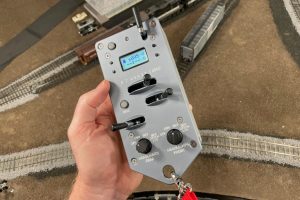
Here are some other things I’ve programmed into the Proto Throttle:
- Programmed my Tsunami2s to disable auto start and programmed the RPM+ and RPM- functions into the Proto Throttle’s “engine on / engine off” screen to produce startup and shutdown sound sequences
- Programmed the prominent “auxiliary” button on the throttle face as “emergency stop” which may save the day with all the momentum in the decoders
- Programmed the small up/down buttons next to the screen for the “coupler” and “coupler release” sound effects for crews that want to include those
- Reprogrammed the notching on the Proto Throttle to start slower (speed step 1) and have fewer speed steps between notches 1 and 5–this allows finer slow-speed control, and my speed curves above 15 mph are flat, so notches 5-8 are really just for increased engine RPMs rather than speed (big steps are fine)
I’m sure I’ll tweak some settings as I learn more, but they’re already a lot of fun! One thing I also learned is it’s not enough to just remap the functions in the Tsunami2 decoders. I’m using “advanced consisting,” so you also have to program these newly remapped functions to respond to the CONSIST ADDRESS and not just the unit address. This caused a little puzzlement until I finally figured out why my changes weren’t working.
One final very minor update I made since the last ops session is to change the town names on the fascia to resemble Southern-style station name boards. These stand out a lot better than the old dry transfer lettering I had before, and they give the layout a little more Southern Railway flair. Of course, the town name for Pennington (L&N staging) is done in black with yellow serif lettering after the L&N’s preference for station signs.
